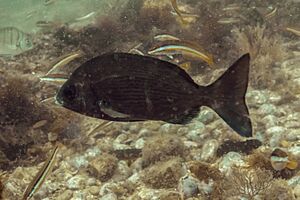Black seabream facts for kids
The black seabream (Spondyliosoma cantharus) is a cool type of fish that has fins supported by bony rays. It belongs to the family called Sparidae, which includes other fish like seabreams and porgies. You can find this fish in many places, including the eastern Atlantic Ocean, the Mediterranean Sea, and the Black Sea. The black seabream is a popular fish to eat, especially in Europe.
Quick facts for kids Black seabream |
|
|---|---|
 |
|
| Conservation status | |
| Scientific classification | |
 |
|
| Range of black seabream | |
| Synonyms | |
|
Contents
What's in a Name?
How the Black Seabream Got Its Name
The black seabream was first officially named Sparus cantharus by a famous scientist named Carl Linnaeus way back in 1758. He wrote about it in his book, the 10th edition of Systema Naturae. Later, in 1849, another scientist named Theodore Cantor gave it the name Spondyliosoma.
Meaning of Spondyliosoma cantharus
The name Spondyliosoma is a bit of a mystery! It comes from two Greek words: spondylus, which means "spindle", and soma, which means "body". No one is quite sure why Cantor chose this name. The second part of its name, cantharus, comes from an Ancient Greek word, kantharos, which was the old name for this fish. Even the ancient Greek philosopher Aristotle knew this fish by that name!
What Does a Black Seabream Look Like?
The black seabream has a body that is fairly deep, but not too wide. Its head is small and round, and its mouth can open wide, reaching almost to the front of its eye.
Fins and Scales
Its dorsal fin (the one on its back) has 11 strong spines and 11 to 13 soft rays. The anal fin (on its belly) has 3 spines and 9 to 11 soft rays. When the fish gets older, the top of its head becomes a bit rounded. Its cheeks and gill covers (called the operculum and preoperculum) do not have scales.
Teeth and Tail
Inside its mouth, it has 4 to 6 rows of cone-shaped teeth. The teeth at the front of its mouth are bigger. Its tail fin is slightly forked, like a "V" shape.
Colors and Size
The black seabream is usually dark grey on its upper body and silvery on its sides. It has about 6 to 9 dark stripes running up and down its body. When male black seabreams are nesting, they can turn almost completely black! This fish can grow up to 60 centimeters (about 2 feet) long, but it's more common to see them around 30 centimeters (about 1 foot). The heaviest one ever recorded weighed about 1.2 kilograms (around 2.6 pounds).
Where Do Black Seabreams Live?
You can find black seabreams in a large area of the eastern Atlantic Ocean. They live from Scandinavia in the north all the way down to Namibia in the south. They also live around the islands of Macaronesia, in the Mediterranean Sea, and in the western Black Sea. These fish usually live in waters that are 5 to 300 meters (about 16 to 984 feet) deep. They like to hang out near seagrass beds, rocky areas, and sandy bottoms.
Black Seabream Life Cycle and Habits
What Do They Eat?
Black seabreams are omnivorous, which means they eat both plants and animals. They munch on algae (seaweed) and small creatures that live on the seafloor, especially crustaceans like crabs and shrimp. They often swim together in large schools.
How They Reproduce
This species is a protogynous hermaphrodite. This is a fancy way of saying they start their lives as females and then can change into males later! Female black seabreams can start having babies when they are about two years old and around 17.3 centimeters (about 6.8 inches) long. Males become mature when they are about three years old and around 22.7 centimeters (about 8.9 inches) long. Once they become males, they usually stay male until they reach about 30 centimeters (about 1 foot). Any black seabream longer than 40 centimeters (about 1.3 feet) is usually a female.
In places like Britain and Ireland, black seabreams lay their eggs in April and May. During this time, they move from deeper offshore waters closer to the coast. The male fish digs a shallow dip in the sand or gravel, piling up the dirt around the edges to make a crater-like nest. The female then lays her eggs in this nest. The male guards the eggs from other fish that might want to eat them and keeps the nest clean until the eggs hatch. In warmer places further south, they lay their eggs earlier in the year.
Black Seabream and Fishing
The black seabream is a popular fish to eat, so it's important for both commercial fishing (big boats that catch lots of fish) and for people who fish for fun, especially during the time they lay their eggs. People catch them all over their habitat, but especially north of Senegal.
How They Are Caught
Fishermen use different ways to catch them, like line fishing, trawling (dragging a net behind a boat), beach seines (nets pulled onto the beach), fixed nets, and fish traps. They are caught all year round, but the amount caught changes with the seasons.
What Happens to the Catch?
Black seabream is sold fresh, frozen, or even salted and dried. Its meat is considered very tasty! Some of the fish caught are also used to make fish meal (food for other animals) and fish oil. You can often find black seabream in markets in Tunisia, Morocco, Italy, Cyprus, Greece, Turkey, and Sicily. In Portugal, about 3,200 tonnes (about 7 million pounds) of this fish are caught each year, making it a very important fish for local fishermen.


